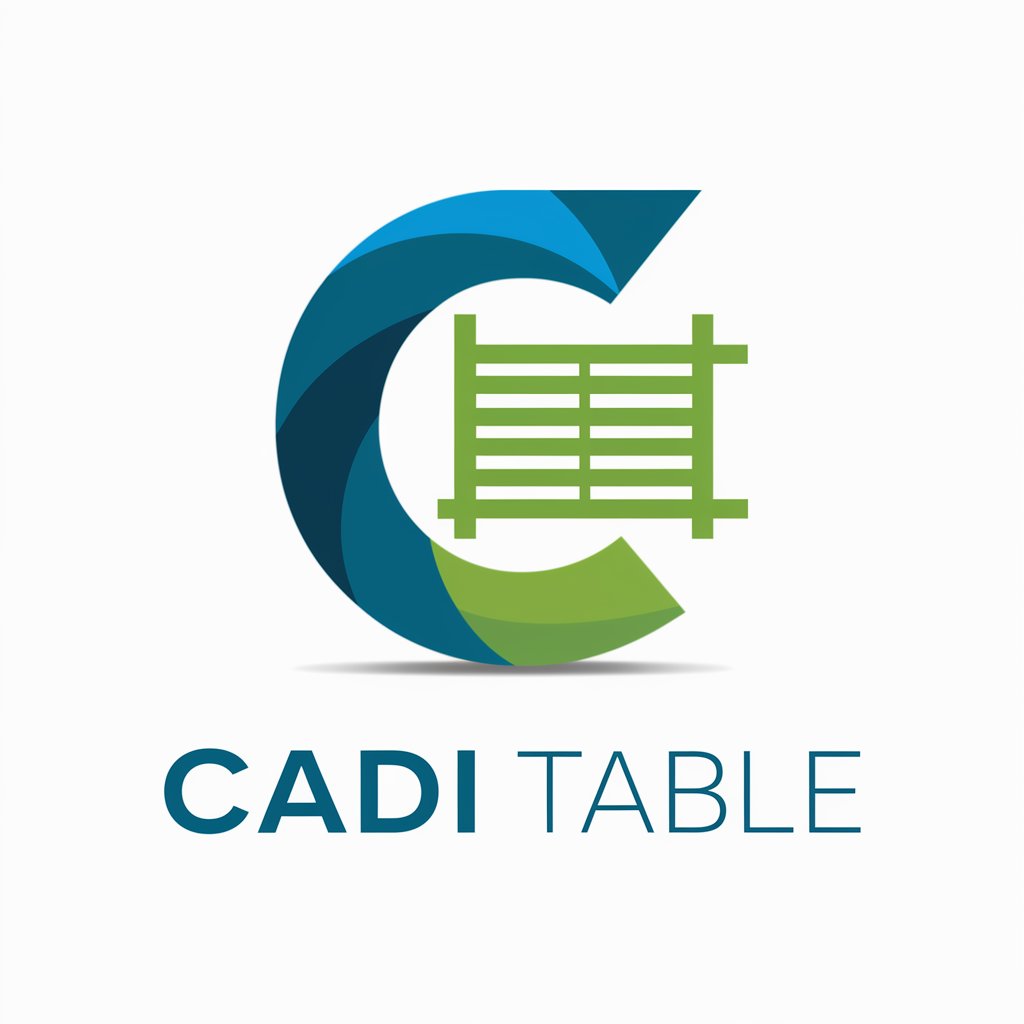CaDi Table - Data Table Creation and Management

Hello! How can I assist you with your data and table needs today?
Transform Data into Tables Effortlessly with AI
Generate a table summarizing the data from the provided Excel file...
Create a table that combines the information from these two images...
Organize the following text data into a clear and concise table...
Based on the attached document, produce a table that highlights the key points...
Get Embed Code
Overview of CaDi Table
CaDi Table is a specialized GPT model designed to excel in generating, interpreting, and manipulating tables from a variety of data sources, including Excel files and images. Its core functionality revolves around data organization and accuracy. This tool is adept at understanding relationships between different data types, whether they're textual or visual, and seamlessly integrates this information into cohesive and accurate tables. It's particularly efficient in scenarios where data from multiple formats needs to be aggregated or compared. For example, CaDi Table can take sales figures from an Excel spreadsheet and customer demographics from an image of a pie chart, and then synthesize this information into a comprehensive table that offers insightful correlations. Powered by ChatGPT-4o。

Primary Functions of CaDi Table
Data Aggregation
Example
Compiling sales data from multiple Excel files into a single comprehensive table.
Scenario
A retail chain wants to analyze quarterly sales data from various locations. CaDi Table can aggregate these figures from multiple Excel sheets, providing a unified view of sales performance across the chain.
Data Interpretation from Images
Example
Extracting data from a bar graph image and converting it into a tabular format.
Scenario
A marketing team has a printed report with important bar graphs. CaDi Table can interpret these graphs, extracting the key data points to form a table, which can then be analyzed or integrated with other data.
Data Augmentation
Example
Enriching a customer database with additional information from supplementary files.
Scenario
An e-commerce company has a customer list and separate image files containing purchase preferences. CaDi Table can augment the customer list with this additional information, creating a more detailed customer profile database.
Target User Groups for CaDi Table
Business Analysts
Professionals who deal with large volumes of data from various sources. They can use CaDi Table to synthesize and analyze data efficiently, aiding in decision-making processes.
Academic Researchers
Researchers who work with complex datasets, often in varied formats, can use CaDi Table to organize and cross-reference data, thus enhancing their research analysis.
Data Journalists
Journalists who need to interpret and present data in an understandable format will find CaDi Table useful for converting complex datasets into clear, concise tables for their reporting.

How to Use CaDi Table: A Guide
Begin with a Free Trial
Start by accessing yeschat.ai for an immediate free trial, no ChatGPT Plus subscription or login required.
Prepare Your Data
Gather the files or images containing the data you want to convert into tables. Ensure the data is clear and readable.
Upload Your Files
On the CaDi Table platform, upload the files or images. The tool supports various formats like Excel, CSV, and JPEG for images with text.
Customize Your Table
Use the customization options to define how your table should look, including column names, data format, and any specific relationships between datasets.
Generate and Download
Click 'Generate' to create your table. Review the table for accuracy, then download it in your preferred format, such as Excel or PDF.
Try other advanced and practical GPTs
NorskLov
Empowering Legal Clarity with AI

Judge Chat will preside over oral argument
AI-powered courtroom argument simulation

Presidentify
Campaign in style with AI-powered posters

Synonymer
Enrich Your Language with AI-Powered Synonyms

Presidents' Fact Guide
Uncover Presidential Histories with AI

Presiden KKP
Igniting Creativity with AI

RLS Wireless
Empowering Wireless Deployments with AI

Timeless Teddy
Engage, Learn, and Imagine with AI

Timeless Vintage
Reviving the past with AI-powered creativity.

Wireless Wizard
Mastering wireless communication, simplified.

Timeless Trends
Elevate Time with AI-Powered Precision

Timeless Artisan
Crafting Art with AI's Touch

Frequently Asked Questions About CaDi Table
What file formats does CaDi Table support for data import?
CaDi Table supports various file formats, including Excel (.xlsx), CSV files for text data, and JPEG or PNG formats for images containing data.
Can I use CaDi Table to extract data from images?
Yes, CaDi Table is equipped with OCR (Optical Character Recognition) technology, enabling it to extract text from images and convert it into a structured table format.
How does CaDi Table ensure the accuracy of the data in tables?
CaDi Table uses advanced AI algorithms to interpret and organize data accurately. Users are also provided with tools to manually adjust and verify data before finalizing the table.
Is CaDi Table suitable for academic research?
Absolutely. CaDi Table can assist researchers by efficiently organizing data into tables, making it easier to analyze and draw conclusions for academic papers.
How can businesses benefit from CaDi Table?
Businesses can use CaDi Table to streamline data management, analyze sales or financial data, and enhance reporting efficiency, thereby saving time and improving decision-making.
